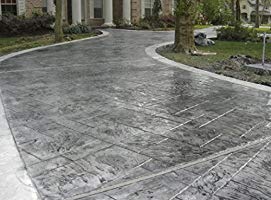What do you think of when you hear the word ‘concrete’?
Driveways? Unfinished basement floors? Sidewalks?
But concrete is so much more. When designed and installed correctly, decorative concrete can match the beauty of stonework, hardwood, or even marble. And it’s not just a material for outdoors. When effectively used – and sealed with a wet look sealer for concrete – it can become a beautiful flooring indoors as well.
The keys to getting that extra ‘oomph’ from your concrete are fairly simple:
• Finding an installer who is skilled at creating and applying your desired design.
• Finding the right sealer for your concrete
Decorative concrete needs a sealer for several reasons. First, it protects your concrete, ensuring that you get to enjoy it for years to come. And second, because the right sealer can really make your decorative concrete come alive and help maintain its beauty long-term.
Wet look sealer can make your concrete’s design pop! But when you start looking for a sealer to use, you’ll quickly realize that there are a lot of options out there. Each of those options has pros and cons to consider. And some have the potential to ruin the design of your decorative concrete. So, it’s important to choose carefully.
Here are a few questions to ask before you buy.
1. Is this wet look sealer for concrete compatible with my design?
You should always make sure that the sealer you’re purchasing is compatible with the surface you’ll be applying it to. This is particularly important if your concrete has an overlay or coloring agent applied to it. Adding certain wet look sealers on top of these can cause colors to bleed or even lead to bubbling.
So, if you’ve got an overlay on your concrete’s surface, make sure to check the manufacturer’s recommendations for the right sealer. And just to be safe, you may want to use whatever sealer the manufacturer sells specifically for that use.
2. What will my wet look sealer for concreate be exposed to?
Depending on where your decorative concrete is located, different kinds of sealer will be needed. For example, if you’re pouring a stamped driveway, you’ll want to make sure that your wet look sealer is equipped to deal with oil and grease stains – in this case, a solvent-based or water-based acrylic sealer would likely be best. On the other hand, if you’re installing an interior floor, you’ll want to make sure that the sealer you choose can resist scuffs and stains – in that case, you’ll want something made from epoxy or polyurethane.
This is why the environment of your decorative concrete is an important factor to remember when choosing which sealer to apply.
3. How quickly will I need to use the area that includes the wet look sealer for concrete?
You may want to factor in the amount of time between application and when you need to use the area as you select your sealer. Acrylic sealers are fast drying, setting within 30 to 60 minutes and making light traffic possible within twelve hours. Epoxies, on the other hand, require at least twenty-four hours of curing time.
These are just a few questions that you’ll want to ask yourself as you decide which wet look sealer to choose for your decorative concrete. In addition, you may want to check the following as well…
• Is this sealer appropriate for indoor/outdoor use?
• Do I want a shinier appearance (you’ll likely want an acrylic sealer) or do I want it to be more muted (you’ll likely want a penetrating sealer)?
• How long can I expect this sealer to last?
• Does the VOC content in this sealer meet current regulations?

